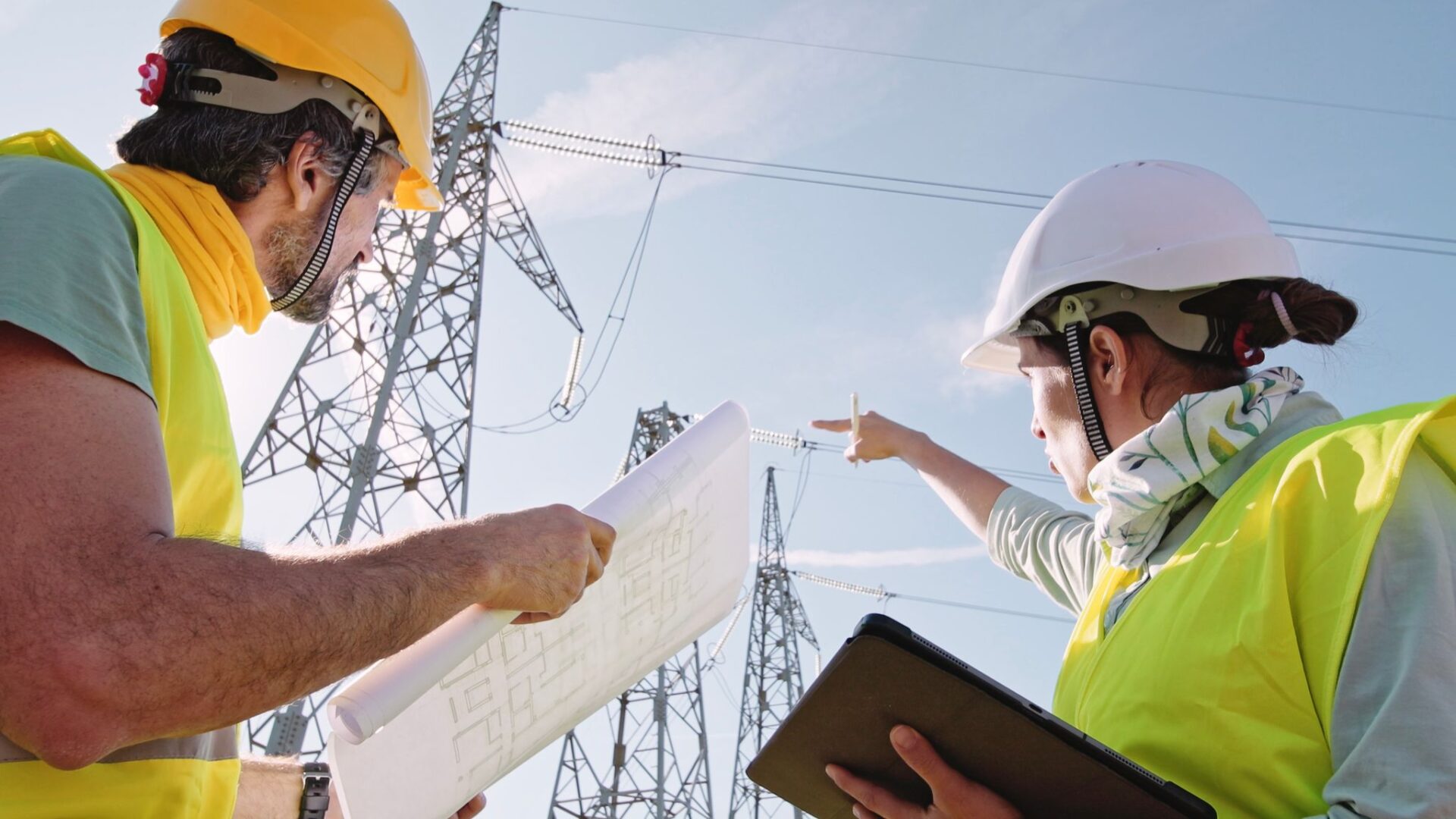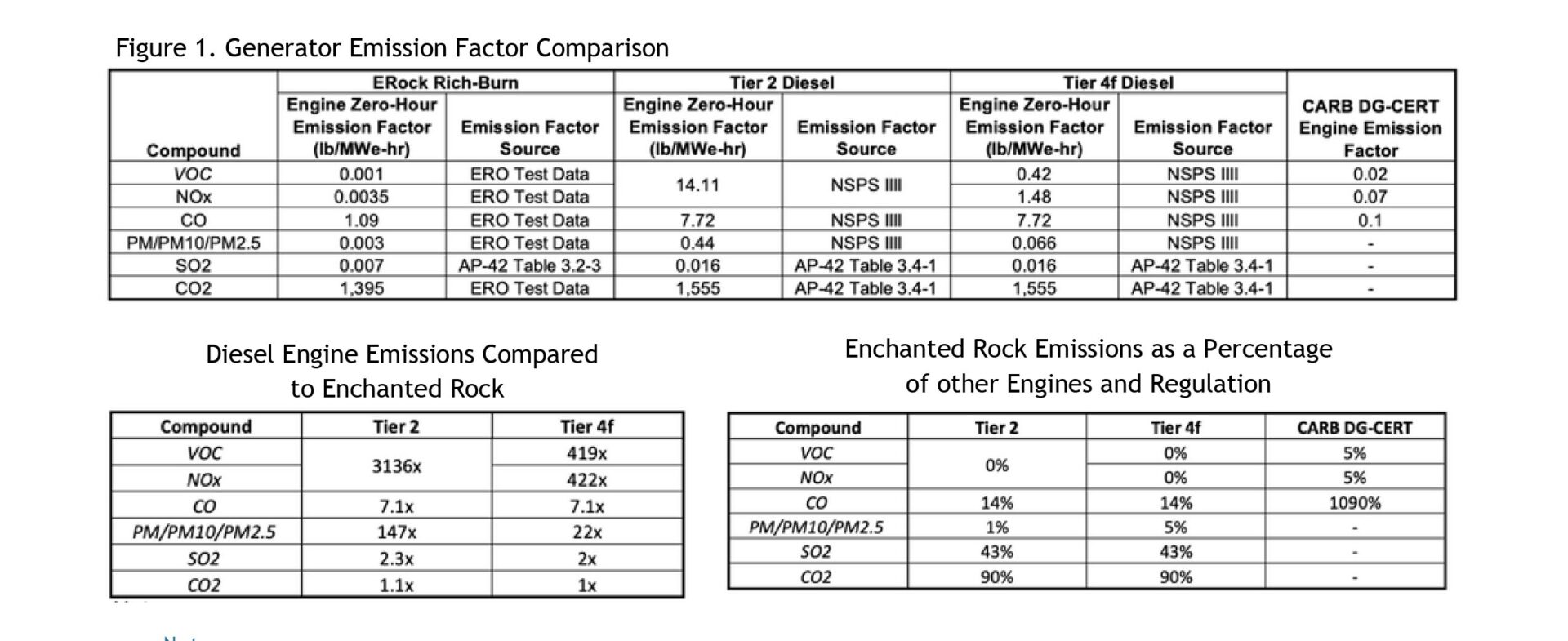[datacenter_tag_image]
At Enchanted Rock, our mission is to keep the power on for customers with cutting-edge electrical resiliency technology. Enchanted Rock continues to invest in ongoing innovation and development to advance the efforts to decarbonize the grid and provide local resiliency.
At Enchanted Rock, our mission is to keep the power on for customers with cutting-edge electrical resiliency technology. Enchanted Rock continues to invest in ongoing innovation and development to advance the efforts to decarbonize the grid and provide local resiliency.
How much cleaner can gas generators be compared to diesel generators?
First, some history. In 2014, we decided to migrate from diesel technology to natural gas technology. We scoured the market to find a cleaner alternative that also met the stringent requirements for backup generation. Essential criteria were start times and transient response, power density, and cost. We learned the market did not offer such a solution, since diesel was so dominant and the only innovation was a new diesel emissions standard (i.e. EPA Tier 4 Final) that was still too dirty and much more expensive due to complex emissions control technology. We recognized this as a market opportunity.
Fast forward, our now patented gas reciprocating engines meet all performance requirements and are far cleaner than the traditional diesel backup systems currently being used – including Tier 4 diesel, also known as “clean diesel.” In fact, our emissions are low enough to run virtually unlimited hours during nonemergency conditions and can be authorized in non-attainment areas using standard air permits. This critical factor provides cost competitive alternatives to diesel generators by offering local resiliency and grid stabilization services to offset the cost of backup power.
We’re not stopping there either. We integrate load controls and behind-the-meter solar and use renewable natural gas to further decarbonize our Managed Power Resiliency offering.
While evaluating your energy transition toward decarbonization, every facility must make an informed decision based on organizational goals and requirements. Unfortunately, there is conflicting information and confusion in the market today, so let’s take a look at some of those statements to separate fact from fiction.
Emissions from new diesel engine generators are regulated by the EPA for NOx, VOCs, Particulate Matter (PM), and CO. When compared to these regulated emissions levels, Enchanted Rock’s generators are significantly cleaner.
Enchanted Rock’s natural gas microgrids offer cleaner local emissions than diesel by orders of magnitude with practically no run limitations – allowing facilities to support both resiliency and sustainable strategies. Our systems use natural gas, propane, and biogas to reduce or eliminate our carbon footprint.
On the topic of renewable natural gas, in a recent report from The Brattle Group, “Decarbonized Resilience: Assessing Alternatives to Diesel Backup Power,” four scenarios are evaluated as alternatives to diesel. The report finds that “relative to diesel, these alternatives can virtually eliminate the emission of pollutants such as NOx, particulate matter, and volatile organic compounds, which contribute to local air quality problems.”
The numbers speak for themselves. As you can see in Figure 1, the Enchanted Rock emissions are far less than that of a Tier 4 diesel engine output across the board.
What is RNG?
Renewable natural gas, or RNG, is pipelinequality gas that is interchangeable with conventional natural gas. RNG is the product of the decomposition of organic matter (biogas) that is processed to purity standards.
No, RNG is an ultra-clean and ultralowcarbon natural gas alternative that is a mixture of carbon dioxide and hydrocarbons, primarily methane gas. It is captured when organic waste decomposes and releases biogas, which is collected and purified. Sources include landfills, livestock operations, wastewater treatment, and organic waste from industrial, institutional, and commercial entities.
RNG can be carbon negative depending on the source and its intended use. Instead of methane gas being released into the air, it is captured, processed, and then injected into a common carrier pipeline which then mixes the conventional NG molecules. Then through off-setting properties that match up with voulmes that are combusted in an engine where the byproduct is carbon dioxide and electricity. Because the carbon intensity of methane gas is 25 times greater than the carbon intensity of carbon dioxide, displacing methane results in significantly lower greenhouse gas emissions.

Notes:
A recent study by the National Renewable Energy Laboratory (NREL), “A Comparison of Fuel Choice for Backup Generators,” analyzes the relative reliability of using natural gas compared to diesel as a backup fuel source. Their conclusion is: “We find that natural gas provides the largest additional reliability compared to diesel for regions that have high risks of long outages.”
Fuel availability and transportation also need to be considered. Natural gas is delivered through an incredibility robust underground infrastructure. During crisis situations, natural gas is readily available when diesel refueling is not always possible due to terminal supply shortages or over-the-road hazards. Enchanted Rock systems can run independently in island mode for days to weeks with no need for refueling logistics.
The reality is that constant conditioning and testing of engines leads to a higher level of reliability. Enchanted Rock natural gas-fueled microgrids run loaded while providing grid stability services, unlike diesel engines which are significantly limited in run hours.
While diesel generators can be less expensive capital cost on a standalone basis, that is not the case for a dual purpose microgrid. By combining backup power with grid stability services, the net cost of natural gas services are lower than diesel. The NREL study concludes, “grid connected generators can create positive economic value and have significantly lower failure rates than backup-only generators.”
Enchanted Rock’s Electrical Resiliency-as-a-Service offering allows customers to focus on their core business while we provide local resiliency, manage the assets and are responsible for maintenance and operations. When customers do not require backup power, Enchanted Rock aggregates the generator capacity and sells back to the grid to earn revenue. These periodic runs allow us substantially subsidize the cost to customers.
A dual-purpose microgrid offers significant economic advantages for our customers, including lowering initial cost to implement and ongoing maintenance and fuel costs. While diesel normally averages $400-500/kw plus a lifetime of maintenance, natural gas microgrids run $150-300/kw with no added cost for maintenance – a significant difference!
Founded in 2006, Enchanted Rock is a leader in electrical resiliency-as-a-service, powering companies, critical infrastructure, and communities to ensure operational continuity during unexpected power outages from extreme weather, infrastructure failures, cyberattacks and other grid disruptions. Enchanted Rock’s dual-purpose microgrids use natural gas and renewable natural gas (RNG) offsets to produce significantly lower carbon emissions and air pollutants than diesel generators, capable of achieving resiliency with net-zero emissions. Additionally, the company’s end-to-end microgrid software platform, GraniteEcosystem™, provides real- time 24/7/365 system monitoring and optimization, including forecasting of electricity market conditions to ensure worry- free reliable power to customers.
Consistent maintenance of the system is vital to ensuring that you will have power when youdemand it. No other backup system can provide a higher level of assurance when you need it most. Enchanted Rock uses clean-burning natural gas. The NOx zero-hour emissions for Enchanted Rock’s natural gas gensets is 10-100 times cleaner or lower than diesel and a fraction of the cost. The NOx emissions for Enchanted Rock’s resiliency microgrids are less than 1% of the standard Tier 2 diesel generator traditionally used for backup.
Enchanted Rock’s dual-purpose microgrids provide you with power during grid failures. When you do not need backup power, Enchanted Rock’s gensets supply the grid with a quick start generation source during stressful operating conditions, helping to stabilize the grid while providing a highly reliable and ultra-clean alternative to diesel generation. The added power to the grid supports renewable energy sources such as wind and solar – by supplying capacity to the grid when renewable power may be low. There is no disruption to your operations during Enchanted Rock’s grid participation.
Traditional diesel systems often fail due to infrequent testing or dependence on over-the-road fuel delivery that is not always possible during natural disasters. Enchanted Rock is unique. When our customers aren’t in need of backup power, Enchanted Rock uses underground continuous fuel delivery with and continuously monitors and tests the natural gas fired generation by selling services back to the US power grid, so when you demand power, it will be ready in seconds.
Founded in 2006, we are the national leader in clean electrical resiliency-as-aservice, powering companies, critical infrastructure, and communities to ensure business continuity during unexpected power outages from extreme weather, infrastructure failures, cyberattacks, and other grid disruptions.
Enchanted Rock’s electrical microgrids uses natural gas and renewable natural gas (RNG) to produce significantly lower carbon emissions and air pollutants than diesel generators and can achieve resiliency with net-zero emissions. The company’s end-to-end microgrid software platform, GraniteOS, provides realtime 24/7/365 system monitoring and optimization, including forecasting of electricity market conditions to ensure worry-free reliable power to customers.